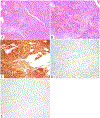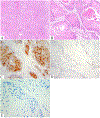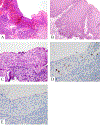Incidence and Clinicopathologic Characteristics of Human Papillomavirus-independent Invasive Squamous Cell Carcinomas of the Cervix: A Morphologic, Immunohistochemical, and Human Papilloma-Virologic Study of 670 Cases
- PMID: 37702216
- PMCID: PMC10840845
- DOI: 10.1097/PAS.0000000000002122
Incidence and Clinicopathologic Characteristics of Human Papillomavirus-independent Invasive Squamous Cell Carcinomas of the Cervix: A Morphologic, Immunohistochemical, and Human Papilloma-Virologic Study of 670 Cases
Abstract
We aimed to determine the frequency of human papillomavirus-independent (HPVI) cervical squamous cell carcinoma (SCC) and to describe clinicopathologic characteristics. Among 670 patients with surgically treated SCCs in an established multi-institutional cohort, 447 had available tissue. Tissue microarrays were constructed and studied by in situ hybridization (ISH) for high-risk and low-risk human papillomavirus (HPV) mRNA and immunohistochemistry for p16 and p53. Tumors were HPVI if negative by HPV ISH and they failed to show diffuse p16 positivity by immunohistochemistry, and human papillomavirus-associated (HPVA) if positive by HPV ISH. Ten HPVI SCCs and 435 HPVA SCCs were identified; 2 cases were equivocal and excluded from analysis. The overall rate of HPVI SCC was low (2%) but was higher among older patients (7% in patients above 60 y of age and 17% in patients above 70 y of age). Compared with HPVA, patients with HPVI SCC were significantly older (median age, 72 vs. 49, P <0.001) and diagnosed at a higher stage (40% vs. 18% with stage III/IV disease, P =0.055). p53 expression was varied; 2 cases (20%) had null expression and 8 (80%) had wild-type expression. HPVI SCCs were heterogenous, with keratinizing, nonkeratinizing, and warty morphologies observed. Several cases had a precursor lesion reminiscent of differentiated vulvar intraepithelial neoplasia, with prominent basal atypia and hypereosinophilia or a basaloid-like morphology. Two patients (20%) had distant recurrences within 12 months, and 3 (30%) died of disease during follow-up. HPVI SCCs are rare tumors that are more common among older patients with higher stage disease and have important clinical and histologic differences from HPVA SCCs.
Copyright © 2023 Wolters Kluwer Health, Inc. All rights reserved.
Conflict of interest statement
Conflicts of Interest and Source of Funding: Funded in part by the National Institutes of Health (NIH)/National Cancer Institute (NCI) Cancer Center Support Grant P30 CA008748. Outside the submitted work, N.R.A.-R. reports research funding paid to the institution from GRAIL. A.I. reports consulting fees from Mylan. For the remaining authors none were declared.
Figures





References
-
- Sung H, et al., Global Cancer Statistics 2020: GLOBOCAN Estimates of Incidence and Mortality Worldwide for 36 Cancers in 185 Countries. CA Cancer J Clin, 2021. 71(3): p. 209–249. - PubMed
-
- Bray F, et al., Incidence trends of adenocarcinoma of the cervix in 13 European countries. Cancer Epidemiol Biomarkers Prev, 2005. 14(9): p. 2191–9. - PubMed
-
- de Sanjose S, et al., Human papillomavirus genotype attribution in invasive cervical cancer: a retrospective cross-sectional worldwide study. Lancet Oncol, 2010. 11(11): p. 1048–56. - PubMed
-
- Smith HO, et al., The rising incidence of adenocarcinoma relative to squamous cell carcinoma of the uterine cervix in the United States--a 24-year population-based study. Gynecol Oncol, 2000. 78(2): p. 97–105. - PubMed
-
- Vesterinen E, Forss M, and Nieminen U, Increase of cervical adenocarcinoma: a report of 520 cases of cervical carcinoma including 112 tumors with glandular elements. Gynecol Oncol, 1989. 33(1): p. 49–53. - PubMed
Publication types
MeSH terms
Substances
Grants and funding
LinkOut - more resources
Full Text Sources
Medical
Research Materials
Miscellaneous

